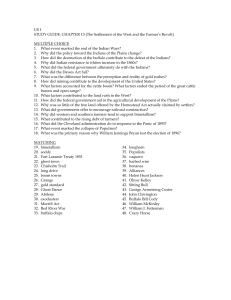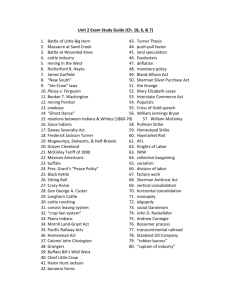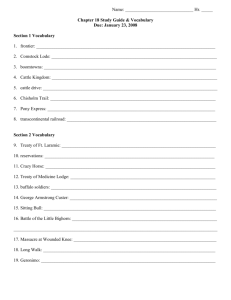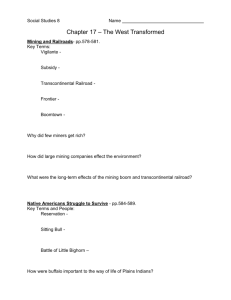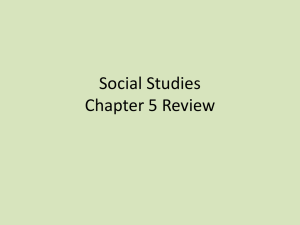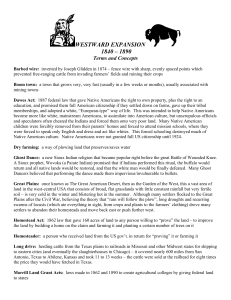Ch 7 3-4
advertisement
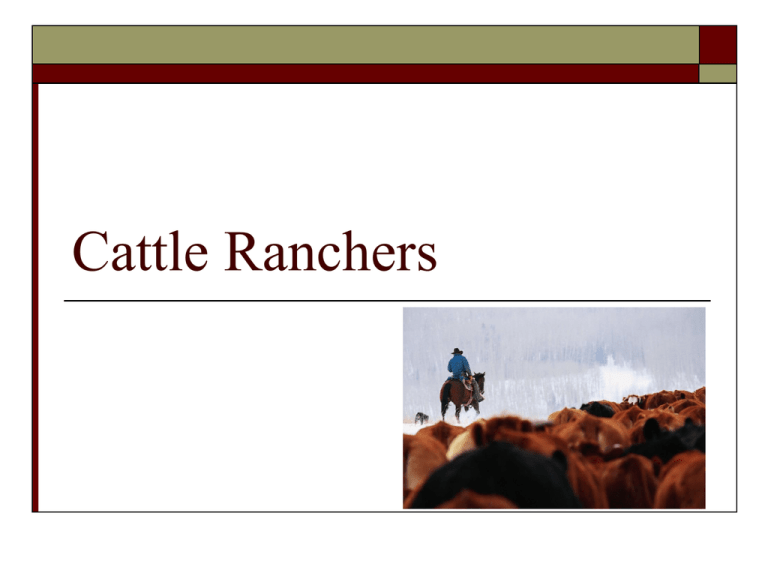
Cattle Ranchers Texas Cattle In the 1800’s, ranchers in Texas raised and sold longhorn cattle. Texas had a lot of cattle, but the market was not good. Cattle sold for only $4.00 each. In the eastern and northern parts of the country, cattle sold for about $40 each. This difference was because of supply and demand. Demand is the amount of something that people want to buy at certain prices. When the prices are low, people usually buy more of it. Supply is the amount of something that people want to sell at certain prices. When the price is high, people want to produce and sell more of it. GPS SS5E1b The Cattle Drives Cowhands led cattle to railroads, where the cattle were shipped to eastern and northern cities. Ranchers wanted to sell their cattle to eastern and northern cities where supply was low and demand was high. To get them to the cities they had to lead them to railheads. A railhead is a town where the tracks begin or end. Because the railheads sometimes were hundreds of miles away, cowhands had to lead them on cattle drives. Life on the Drives (see map on page 240) A cowhands job was hard, sometimes boring, and usually dirty. Often the cowhands were African Americans or Mexicans. One well known African American cowhand was Nat Love, who wrote a book about life on the trail. One famous trail is the Chisholm Trail. The trail stretched from southern Texas across the Red River, and on to the railhead in Abilene, Kansas. GPS SS5H3a The End of the Drives Cattle drives ended for several reasons. One reason was the invention of barbed wire. Barbed wire is twisted wire with a sharp point every few inches. Barbed wire was put up by new settlers and cattle drives could not cross the land as easily. Also the growth of more railroads. After railroads were built in Texas, cowhands could ship their cattle. Conflicts on the Plains American Indians and settlers fought on the Great Plains in the late 1800s. Settlers were moving west in search of gold or land. They settled on land already lived on by American Indians. The Government built roads and railroads on the land. They tried to convince the American Indians to move to reservations. A reservation is land that the government set aside for American Indians. GPS SS5H3 Conflicts on the Plains The Government hoped that the Plains Indians would move to the reservations and begin farming. But the Plains Indians were used to hunting buffalo and moving around. They didn’t want to move. Plains Indians fought soldiers who tried to force them onto reservations. Most of the fighting occurred in the 1860s and 1870s. Sand Creek Massacre In 1864, volunteer fighters of the Colorado militia attacked a Cheyenne Indian village near Sand Creek, Colorado. The village people were asleep. Chief Black Kettle raised a white flag and an American flag to surrender, but it was ignored. The soldiers continued to kill almost half of the men, women, and children. After this massacre, the Plains Indians did not believe that peace was possible with the U.S. Government. Battle of the Little Bighorn The Black Hills of South Dakota and Wyoming are sacred to the Lakota Indian tribe. In the 1870s Lieutenant colonel George Custer led soldiers to the Black Hills and found gold. Thousands of Lakota and Cheyenne Indians gathered to protect the land. In 1876 Custer tried to force the American Indians on reservations. They attacked them at their village on the Little Bighorn River. Led by Crazy Horse, Gall, and Sitting Bull, the American Indians won, killing all of the U.S. soldiers. GPS SS5H3 e Massacre at Wounded Knee Many Plains Indians followed a religion called Ghost Dance. When Sitting Bull became a ghost dancer, the government sent police to arrest him and he died. Many of the Ghost Dancers, led by Chief Big Foot, were scared and hid in the Badlands of South Dakota. U.S. soldiers captured Big Foot and killed many men, women, and children in the fight. Destruction of the Buffalo Because of the settlers and railroads, many of the buffalo habitats were destroyed. A habitat is the area where an animal or plant normally lives or grows. Settlers killed the buffalo for meat, for sport, or for the skins. This caused the buffalo to become extinct, no longer exists. By 1889, only about 1,000 buffalo were left. Government Policy Government officials tried to force American Indians to change their way of life. Lawmakers tried to get the American Indians to assimilate into American life. Assimilate means changing a group’s culture and traditions so that it blends with a larger group.
